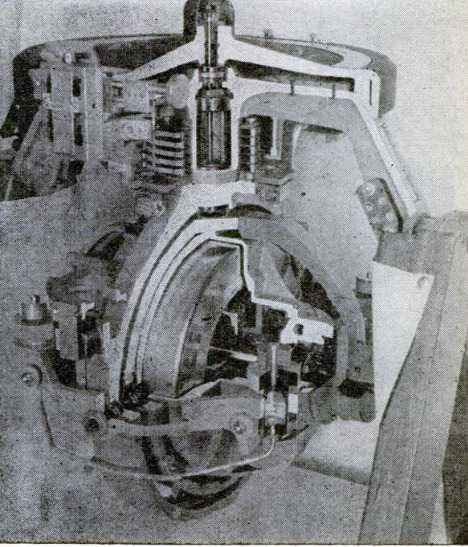-
Title (Dublin Core)
-
The little top that aims a gun
-
Article Title and/or Image Caption (Dublin Core)
-
The little top that aims a gun
-
extracted text (Extract Text)
-
A TINY fast-spinning wheel that used to
be nothing but a child's toy has been
transformed overnight into one of the dead-
liest of our war weapons. The gyroscope has
finally come into its own, and we are making
full use of its uncanny power. It virtually
saved the battleship from the junk pile by |
giving us gunsights that could knock down
Jap planes before they got close enough to |
dive-bomb or launch torpedoes. It made the |
devastating B-29 raids on Japan possible |
without fighter escort. The Superfortresses
can take care of themselves because of two |
spinning wheels no bigger than a baby’s fist
that give their guns accuracy never known |
before. |
The turning point in the Pacific war came
when U. S. “Battleship X” virtually anni-
hilated a force of attacking Jap planes on
October 26, 1942. That was the first major |
tryout of the new gunsights and the first
clear-cut victory of seapower over airpower
in many a day. When the reports of that bat- |
tle came in, it was apparent that something
new had been added since Jap planes sent the |
mighty British warships Repulse and Prince |
of Wales to the bottom in a few minutes. |
The Navy was so thrilled about the new |
gunsight and attached such importance to |
it that even the name of the battleship was |
kept a secret for a long time afterward. |
Now we know that it was the South Dakota,
and the Navy has also revealed the fact that |
its ability to smash attacking planes was |
due to the gyroscopic sights newly installed
on its antiaircraft guns.
Many thousands of the gunsights have
been made since then. They are now in con-
trol of practically all American and British
naval antiaircraft guns, and they have shot
down Jap planes by the hundreds. That is
one reason why our Navy was not afraid to
go within range of Japanese land-based
planes. The Jap navy was chopped down to
near impotence by a succession of defeats.
Some of these were administered by our
surface ships and some by our planes, but
in either case the superior protection of our
fleets against attack from the air gave us a
mighty advantage. Jap pilots knew it was
literally suicide to attack our ships, but they
kept trying. Very few lived to try again,
although a few got through to inflict dam-
age on light naval units.
American inventive genius has given us
these important new weapons, and several
others, by harnessing the peculiar power
that scientists have long known to reside in
the spinning gyro wheel. The principle of
the gyro is a simple one and as old as.the
world itself. The inertia of a spinning mass
is what makes a top stand upright, and this
is the basis of all gyroscope uses. Though
scientific men have known this for more
than 100 years, they made no practical use
of it until early in this century. Their first
use was in a weapon of war, the torpedo, as
a stabilizing agent. Then, in 1911, after
years of labor and discouragement, Elmer
Sperry was given a chance by the U. S.
Navy to prove that a gyrocompass was a
better and more reliable navigating guide
than the time-honored magnetic compass.
The Navy trials were a triumph for the in-
ventor. |
That was the beginning of man's mastery
of another natural law. The gyrocompass,
of course, is now in use on just about every
first-class ship in the world. After that,
Sperry went on to invent the stabilizer that |
takes most of the roll out of ocean-going
steamers. Then he put his gyrocompass to
work as an automatic ship's pilot. For air-
planes he produced the gyro horizon, direc-
tion indicator, and other gyroscopic instru-
ments that first made blind flying possible.
Harnessing these instruments still more, he
made the automatic gyro pilot for planes, |
now in universal use. |
In the First World War, these were the |
only instruments based on the gyroscopic |
principle. In this war, the gyroscope rates
as one of the most important of all agencies
for giving precision and stability to weapons
as well as safety to navigators on the sea |
and in the air. It was the U. S. Navy that |
gave Elmer Sperry recognition for his years
of work on the gyroscope when, in 1911, his
gyrocompass was installed in the then new
battleship Delaware. And it was Sperry's
company that came to the Navy's rescue at
a critical period of its history by developing
and building the gyroscopic gunsight. The
importance of this one invention to the na-
tion can hardly be exaggerated.
Fortunately for this country—and for the
whole civilized world—the Sperry Gyro-
scope Company was laboring over a gyro-
scopic gunsight even before the Japs de-
scended upon Pearl Harbor. In 1940, Sperry
engineers, in collaboration with Dr. C. Stark
Draper, of Massachusetts Institute of Tech-
nology, went to work on a Sperry project of
applying a “rate gyro” to a computing gun-
sight for warships. It was highly desirable
to create a naval sight based on the gyro-
scope because of its ability to maintain its
position in space in spite of a ship's roll and
pitch. Mechanical computers had no such
ability.
The “prescription” for the sight was fi-
nally written. The precision demanded in all
parts was far more exacting than that of
the finest watch. Tolerance of some ele-
ments had to be as small as one ten-thou-
sandth of an inch to make the gunsight ac-
curate. Months of diligent effort under high
pressure brought success. Engineering
brains and ingenuity had written another
brilliant chapter in the history of American
invention.
Almost ridiculously small are the vital
parts that give this gunsight its ability to
shoot speeding planes out of the air with
regularity. The rotors—two to each sight—
are two inches in diameter and weigh less
than a pound each. They are turned by an
air jet shot into slots around the perimeter.
At a speed of 10,000 to 11,000 r.p.m., they
have the necessary inertia to remain inde-
pendent of all influences except those delib-
erately and carefully brought to bear upon
them in order to perform the function of
giving the gun a correct lead in front of the
moving target.
When a spinning wheel, nicely balanced,
is properly hung in gimbal rings, it is en-
tirely independent of all its surroundings—
as if it were a thing apart from the earth.
Its own inertia is its only law, but that law
is absolute. All gyroscopic instruments ob-
tain their peculiar abilities from calculated
efforts to make the spinning rotor violate
this law, a thing the scientists know it will
not do. What the gyro does to preserve its
inertia is to “precess,” that is, to move at a
90-degree angle away from a force applied
against its axis of rotation, Since this move-
ment can be counted upon absolutely, the
inventors exaploy it to do whatever is desired
—to open and close valves, apply and cut off
electric current, and so forth,
The type of instrument employed in the
gunsight is called a “rate gyro.” That is,
it is a gyro controlled
by springs so that the
faster it is made to pre-
cess, the greater the
force it exerts on the
springs. In the gun- |
sight, this force is de-
termined by the rate of |
movement given by the
gunner to the gun in
following the target. |
Fast movement gives
greater force than slow |
movement. This force
is instantly transmitted
to a mechanism that |
offsets the line of sight
from the line of the gun |
bore so that when the
gunner is aiming his
sight at the target, the
gun is actually pointing
ahead of the target by
the right amount so
that the enemy will fly |
into the bursting shell.
All the gunner has to |
do is to follow the tar-
get steadily with the |
sight and pull the trig- |
ger.
When the B-20's were
being designed for the
special mission of long-
range bombing raids on
Japan, it was obvious |
that they would have to |
£0 without fighter es.
cort, so the efficiency of
their guns in protecting
them from enemy fight.
ers was a matter of |
greatest concern. Gen-
eral Electric was given the vitally important
task of designing the controls for these
guns. The central gunnery system invented
for this special purpose is a combination of
electronic, mechanical, and gyroscopic de-
vices that has spelled disaster for the Japs.
(P.S.M., Feb. 45, p. 88.) Here again, the
prodigious task of computing the speed of
an attacking plane relative to that of the
bomber was turned over to two tiny spin-
ning rotors, electrically driven in this case.
It makes no difference to these magical
wheels whether the speed of the fighter must
be added to or subtracted from that of the
Superfortress; it is done instantly. The gun-
ner sits in a warm, pressurized cabin, fol-
lows the target with his sight, and pulls the
trigger that may fire one, two, or three sets
of guns at once. All calculations are auto-
matic and instantaneous. The guns lead the
target by the correct angle at all times.
These are the defensive uses of the gyro
scope in war—important enough, surely,
but only a fraction of the gyro’s contribu-
tion to Winning this war, Gyros are on the
offensive, too—in planes, tanks, ships, sub-
marines, and torpedoes.
When the big bombers—the B-20's and
all the lesser ones—arrive over their target
area, the whole ship is turned over to the
gyroscopes that make the automatic pilot
work. The pombing runs must be straight
and true, and this is managed by the spin-
ning wheels more accurately than any hu-
man hand could do it.
And now the bombing run is on; the vital
moment has arrived for which the great
‘machine and its crew have made the perilous
Journey. Again the gyroscope is called upon
to make the bomb hit the mark. The Nor-
den bombsight is put to work—and two
more of the spinning wheels are doing their
stuff as essential parts of that famous
weapon. (P.S.M., June 45, p. 70.)
There has been a lot of controversy about
the relative potency of our tanks as against
those of the enemy, but in one respect there
is no question of our superiority in this de-
partment: our tanks can shoot straight on
the run. Here, again, the secret Is the gyro-
scope—just one 14-ounce rotor that holds
the biggest tank gun on a true horizontal
line, no matter how much the tank pitches
and rolls over rough terrain. This was an
achievement of Westinghouse (P.S.M., Sept.
'44, p. 82). General Patton, who ought to
know about tanks, gave high praise to the
gyrostabilizer in telling how he had been
able to beat the larger German tanks for
sensational victories. The Germans could
shoot straight only when they stopped dead,
and then they were sitting ducks for targets,
while our tanks kept on the move, firing
with deadly accuracy.
It should be kept in mind that a small
gyroscope, such as those in planes, gun-
sights, and gun stabilizers, has no great
power. A man can move one of these rotors
out of its plane of rotation with his hand.
What it does have is infallible accuracy
when it is nicely balanced and freed from
the element of friction to the degree made
possible by precise manufacturing methods.
The gyro in the tank, for instance, merely
opens and closes magnetic valves, an opera-
tion that takes practically no power. It is
just a matter of making electrical contacts.
Oil pressure, kept up by an independent
pump, does the work of pushing the gun
breech up and down, counteracting every
movement of the tank. The gyro tells it
‘when to push and when to pull.
Let's not forget, either, that it is the same
uncanny gyroscopic power that gives the
biggest guns in our fighting ships a true
vertical reference at all times so they can
fire with accuracy regardless of roll and
pitch. This is certainly an offensive use of
utmost importance. So is the work of gyros
that guide our torpedoes to send Jap ships
to the bottom. The gyroscopes in torpedoes
did us plenty of damage in the Atlantic, but
in the Pacific they have been largely on our
side.
And these are not the only important uses
we are making of gyroscopes to speed this
war to a conclusion. Now that our scientists
Dave really tackled the problem of harness-
ing the gyroscope to man’s purposes, there
is no telling what important new services
they may find for it in the years to come.
GOLD V. SANDERS.
-
Contributor (Dublin Core)
-
Stewart Rouse (article writer)
-
Language (Dublin Core)
-
eng
-
Date Issued (Dublin Core)
-
1945-07
-
pages (Bibliographic Ontology)
-
86-93
-
Rights (Dublin Core)
-
Public domain
-
Archived by (Dublin Core)
-
Sami Akbiyik
-
Marco Bortolami (editor)
 Popular Science Monthly, v. 147, n. 1, 1945
Popular Science Monthly, v. 147, n. 1, 1945
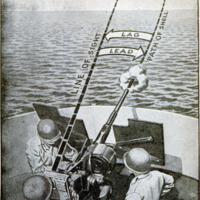 Screenshot 2023-01-19 161415.png
Screenshot 2023-01-19 161415.png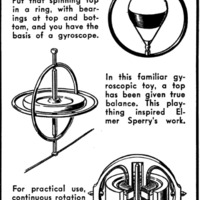 Screenshot 2023-01-19 161328.png
Screenshot 2023-01-19 161328.png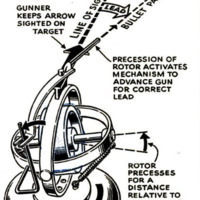 Screenshot 2023-01-19 161427.png
Screenshot 2023-01-19 161427.png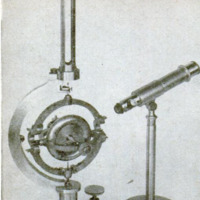 Screenshot 2023-01-19 161440.png
Screenshot 2023-01-19 161440.png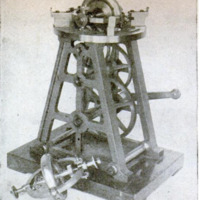 Screenshot 2023-01-19 161451.png
Screenshot 2023-01-19 161451.png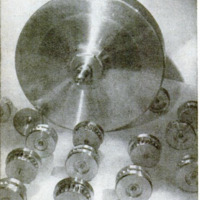 Screenshot 2023-01-19 161503.png
Screenshot 2023-01-19 161503.png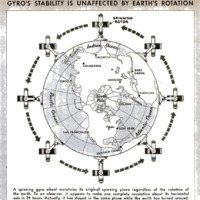 Screenshot 2023-01-19 161515.png
Screenshot 2023-01-19 161515.png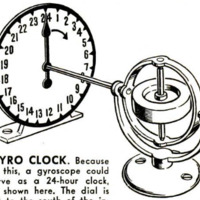 Screenshot 2023-01-19 161534.png
Screenshot 2023-01-19 161534.png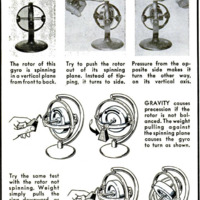 Screenshot 2023-01-19 161548.png
Screenshot 2023-01-19 161548.png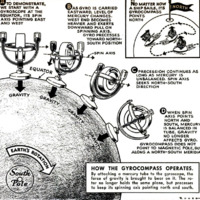 Screenshot 2023-01-19 161601.png
Screenshot 2023-01-19 161601.png Screenshot 2023-01-19 161613.png
Screenshot 2023-01-19 161613.png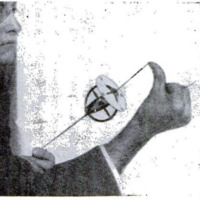 Screenshot 2023-01-19 161626.png
Screenshot 2023-01-19 161626.png Screenshot 2023-01-19 161652.png
Screenshot 2023-01-19 161652.png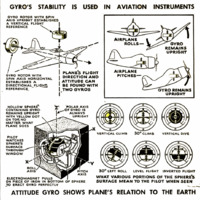 Screenshot 2023-01-19 161706.png
Screenshot 2023-01-19 161706.png










